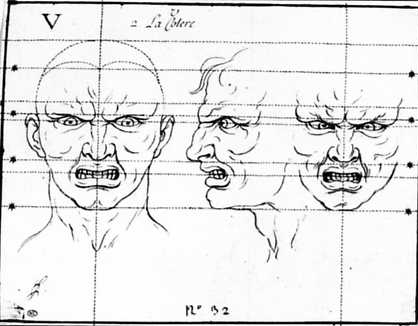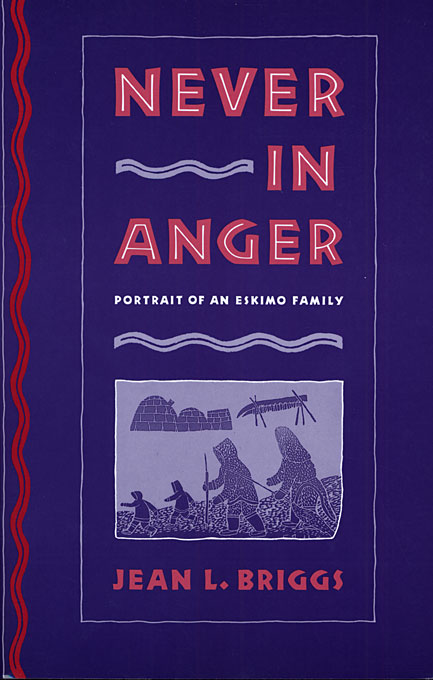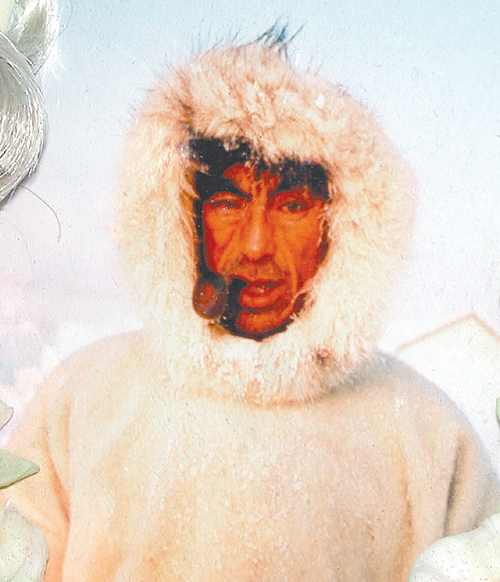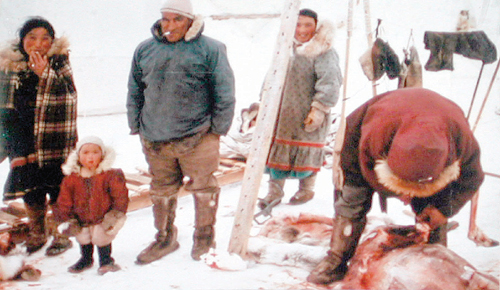The Anthropologist Who Studied and Lived With the Eskimo Family Was Shunned Because:
Thomas Dixon is Manager of the Centre for the History of the Emotions at Queen Mary University of London. His new enquiry – function of the Living With Feeling project – explores the history, philosophy, and feel of acrimony.

'La Colère' past Charles Le Brun
In this, the second in an occasional serial asking 'What is anger?', Thomas discusses the possible answers to that question suggested by a classic piece of work of ethnography by the anthropologist Jean L. Briggs, who died before this yr.
He reflects on parallels between history and anthropology, describes the Inuit civilization of emotional command documented by Briggs'south in her remarkable book Never In Anger (1970), and finally asks where Briggs's enquiry leaves the quest for a universal emotion that corresponds to the English language word 'anger'.
As a pupil of strange feelings, unfamiliar words, and bizarre attitudes towards emotion found in other cultures, I like to recall of myself equally something of an anthropologist. The by, equally has ofttimes been noted, is a foreign land and its inhabitants lived and felt in ways that it takes an effort of scholarship and imagination to recover. The historian of emotions, like the anthropologist, is all as well aware of the differences betwixt their own mindset and worldview and those of the people they are studying, while also hanging on to a sense of some shared humanity and the possibility of making existent, sometimes emotional connections.
The analogy between cultural history and anthropology is a good i, although I realise with some discomfort that while plenty of historians accept described themselves every bit anthropologists of the past, not so many anthropologists tend to line up to avowal that their piece of work is a kind of history. In whatsoever instance, the parallel only goes so far. In my work every bit a historian I take never, for example, risked my life in an extreme climate, isolated myself completely from western civilization for months on end, been ostracized by the people I am studying, or tried to subsist on a nutrition made up predominantly of raw fish. Jean Briggs did all of those things every bit an intrepid graduate educatee in the early 1960s in a remote arctic region. The issue was a classic work of ethnography describing the social lives and emotional dynamics of the small group of Inuit amidst whom she lived. It was published in 1970 and is still in print – Never In Acrimony: Portrait of an Eskimo Family.
 It was Baronial 1963 when Briggs arrived in an expanse of chill tundra in the Canadian Northwest Territories, northwest of Hudson Bay, to study a customs of merely twenty to 30-five individuals, calling themselves the Utkuhikhalingmiut – the only human inhabitants in an area of 35,000 square miles, subsisting through fishing, hunting, and trading. The Utku – Briggs mercifully abbreviates the proper noun throughout – agreed to play host to Briggs, i of the families taking her in as their adoptive daughter. Briggs' intention was to spend a year to eighteen months studying shamans and shamanism. It was only some fourth dimension after her arrival, equally she started to learn the language and ask more questions, that Briggs discovered that the Utku had in fact been converted past missionaries some decades earlier and were at present all devout Anglicans. Indeed, her adoptive father – referred to by the pseudonym 'Inuttiaq' in the volume – was the religious leader of the grouping and led regular prayer meetings and religious services. Without any shamans to report, Briggs had to find a new topic for her research, and she gradually settled upon the emotional dynamics of the group equally her main focus.
It was Baronial 1963 when Briggs arrived in an expanse of chill tundra in the Canadian Northwest Territories, northwest of Hudson Bay, to study a customs of merely twenty to 30-five individuals, calling themselves the Utkuhikhalingmiut – the only human inhabitants in an area of 35,000 square miles, subsisting through fishing, hunting, and trading. The Utku – Briggs mercifully abbreviates the proper noun throughout – agreed to play host to Briggs, i of the families taking her in as their adoptive daughter. Briggs' intention was to spend a year to eighteen months studying shamans and shamanism. It was only some fourth dimension after her arrival, equally she started to learn the language and ask more questions, that Briggs discovered that the Utku had in fact been converted past missionaries some decades earlier and were at present all devout Anglicans. Indeed, her adoptive father – referred to by the pseudonym 'Inuttiaq' in the volume – was the religious leader of the grouping and led regular prayer meetings and religious services. Without any shamans to report, Briggs had to find a new topic for her research, and she gradually settled upon the emotional dynamics of the group equally her main focus.

Briggs's adoptive father Kigeak (referred to as 'Inuttiaq' in her volume) in a photograph taken by Briggs in the early on 1960s. Motion-picture show source: Nunatsiaq News
Briggs'south wonderful volume is involving for many reasons. The descriptions of the setting, climate, and atmosphere are vivid and evocative, giving a sense of the desolate majesty and danger of the icy surroundings. The domestic details are telling as well – from the countless communicable, gutting and eating of fish (I started to feel despair, ennui, and nausea after a while just reading about it), to the techniques for scraping and sewing caribou hide, to the personal habits of her charismatic adoptive father Inuttiaq – fond of delivering not just moralistic sermons and prayers but also lewd jokes. The tense relationship betwixt Briggs (known to her adoptive family as "Yinni") and Inuttiaq is at the centre of the volume, and the way that Briggs includes her ain behaviour, emotions, and attitudes inside the scope of her written report is 1 of the things that fabricated information technology so unusual and successful equally an ethnographic report.
Never In Anger documents, then, not only the prevailing emotional government among the Utku but Briggs'southward attempts (and repeatedly failures) to conform to it. She finds herself, time and again, behaving like a kapluna (that is, a white American outsider) – likewise oftentimes allowing her annoyance, displeasure, and despair to become visible. The resulting tensions finally come to a head when she – believing herself to be expressing Inuttiaq'due south wishes – gets into an angry confrontation with a visiting group of kapluna fishermen, who wish to borrow a canoe (having already carelessly damaged the Utku'southward only other boat). Yinni'due south anger with the fishermen, and so with Inuttiaq, who undermines and reverses her refusal to lend the canoe, and with herself for her failure of cocky-command, leads to months of unhappy resentment and ostracism.
Someone like Yinni who could so easily and frequently lose their temper was, in the eyes of the Utku, equally bad every bit a baby or an animal. Indeed this was a standard twentieth-century Inuit conventionalities nigh kaplunas more than generally – that they were loud, irrational, and bad-tempered like the dogs from whom they were descended (pp. 74, 329). In this we see an ironic mirror image of the mutual belief amidst western colonizers in the nineteenth century that indigenous 'savages', unlike civilized Europeans, were unable to control their emotions.
Learning restraint
Expressions of strong emotions of all kinds were of vanishing rarity amid the Utku. Indeed, an anthropologist visiting rural Kent would observe more outbursts of anger and sadness over my family unit breakfast tabular array on whatsoever given forenoon than Jean Briggs documented in her entire 18 months among the Utku. Inuttiaq, for all his emotional intensity, his strange trigger-happy fantasies, and his vehement beating of his dogs, was a model of restraint when it came to other people. Inuttiaq'south wife Allaq said of her husband that he was the only parent she had known who never got angry with his children (p. 69). Speaking as the father of two young children, I find this a truly astonishing feat, if true. Briggs wrote that she too never saw Inuttiaq lose his temper with anyone. Even some of the Utku found this extreme restraint troubling. Some expressed the view that a man who never lost his temper could do terrible violence – even murder – if he did once become angry (pp. 46-47).
This Utku ideal of emotional self-control was based on a strong contrast betwixt the rules of expression that applied to young children up to the age of about half dozen and older children and adults. Infants and toddlers were allowed to scream and shout, throw tantrums, weep uncontrollably, and generally create bedlam. Older children and adults, however, were supposed to be in possession of an all-of import quality chosen ihuma, which Briggs translates as 'listen', 'reason', or 'will' (pp. 111-12). The possession of ihuma should lead to emotional containment, cocky-command, and most-constant outward calm. Situations that might provoke an explosion of rage from a modern American, Briggs noted, produced zip more than laughter, a shrug, or a 'too bad' from the Utku.

The thriving Utku camp at Back River on a typical solar day in the early 1960s, in a photograph taken by Briggs. The Utku treated Briggs every bit kin, educational activity her their ways and traditions. Picture source: Nunatsiaq News
It was not only anger, but besides other commonplace feelings such as love and sadness, that Briggs was surprised to notice almost imperceptible among Utku adults. The indulgence of infant emotions extended to their being shown physical warmth and affection by adults, but demonstrative loving gestures such as kisses, embraces, holding hands, or linking arms were never seen betwixt husbands and wives or between parents and their older children (p. 117). Separations and reunions between loved ones were marked past cipher more expressive than a gentle handshake, if that. Tears likewise were considered inappropriate for all but the youngest infants. When a 14-yr-former male child allowed a tear to run downwards his cheek when his father was nigh to exist flown to hospital, peradventure never to return, his sis laughed with others well-nigh this amusingly childish behaviour (p. 258).
In a later book, Briggs has documented the utilize of imaginary emotional dramas to teach young Inuit children these habits of cocky-command.1 Adults would provoke and tease children with tests and questions – encouraging them to be greedy, violent, or vindictive – as an indirect way to teach them the opposite virtues of generosity, calmness, and forgiveness. In a 1994 inquiry chapter entitled '"Why Don't You Impale Your Babe Brother?"The Dynamics of Peace in Canadian Inuit Camps', Briggs explains that a heightened awareness of the threats of hostility and mortality led to the creation of these regimes of emotional didactics and control among the Inuit. And of course, of all man emotions, anger is the one most strongly associated with such threats.
Angry Jesus
In a previous mail I explored some of the foundational texts of western moral philosophy, every bit deployed by Martha Nussbaum, as intellectual and moral tools in the restraint of anger. Another cracking text (or drove of texts) conveying ancient ideas about living with feelings is the Bible. And it was to the say-so of God and the Bible that Inuttiaq turned for the underpinning of the Utku emotional authorities – a regime which, incidentally, undoubtedly long predated the community's conversion to Christianity. Ane of the recurring themes of Inuttiaq's stark and direct sermons – one that Briggs couldn't help but feel was directed towards her – was that God would protect people from the clutches of Satan and so long equally they prayed regularly and did non get aroused, and such people would become to sky. Those who did get angry, still, would be taken by Satan and used equally firewood (pp. 52, 56, 257, 267-8).
Given this utilise of God and the Bible to justify such an extreme ban on expressions of anger, it is non surprising to acquire that Inuttiaq showed some embarrassment when trying to explain the story of how Jesus angrily collection the money changers out of the temple. Jesus only behaved similar this in one case, Inuttiaq pointed out, and the money changers were being very bad (pp. 331-ii).
Now this instance of Jesus's cleansing of the temple brings us to the crux of the matter for another reason also. The Utku term used to describe what Jesus did to the coin-changers was huaq – to scold – which is just i of several different words with connotations of acrimony. Never In Angerdemonstrates what happens when someone schooled in one emotional regime has to alive nether the dominion of a quite different regime, and struggles to adapt their behavior, emotions and behaviours accordingly. So far, this can be framed in a fairly standard way as an case of how dissimilar human societies (whether remote from each other in time, space, or cultural distance) can take dissimilar attitudes to the emotion of anger. But of much more importance and interest as far as I am concerned is the way that it can help us to retrieve about whether there is whatever such matter as the emotion of acrimony. Briggs herself, for the sake of brevity and convenience, more often than not refers in her volume to people displaying 'anger' or 'bad temper'. Still, these English labels do not have direct equivalents in the Utku dialect. Never In Acrimony is a book non just near a culture with a strong apparent aversion to what nosotros call "anger" only also one with no unmarried equivalent concept of "anger".
Lust in translation
In an appendix and glossary analysing Utku emotion terms and concepts, Briggs makes several observations about the impossibility of making a tidy one-to-one translation between Utku words and English words. Briggs suggests nine wide emotional 'syndromes', and arranges the various terms under those headings. One of the nine syndromes is 'Sick Temper and Jealousy' and includes 8 different Utku terms, five of which chronicle to assailment and hostility, and three to possessiveness or unhappiness of other kinds (pp. 328-37). The five terms relating to aggression and hostility are huaq – to scold, as Jesus did in the Temple; ningaq – to aggress physically; ningngak – to feel or express hostility; qiquq – to be chock-full up with foreign matter, to experience hostile; urulu – to experience, limited or arouse hostility or annoyance (p. 329).
Let me make four quick points about this. First, and near manifestly, every bit I take said, at that place is no Inuit word for "anger". Secondly, it is notable that there is no reference anywhere to the thought that whatsoever of these Inuit words includes a necessary reference to revenge or pay-back (which is considered a defining characteristic of orge – the Ancient Greek philosophical concept of acrimony adopted by Nussbaum and others). Thirdly these words are primarily, though non exclusively, terms for outward actions – such things as shouting, scolding, threatening, and physically attacking. The Inuit vocabulary as translated by Briggs (and this is reinforced also past another recent linguistic written report) is primarily a behavioural one.ii So, whatever it is that is standing in the place of "anger" or "bad temper" in the worldview of the Utku seems to have been more a set of behaviours than a set of feelings. Finally, Inuit languages do not seem to have an equivalent category to the English 'emotion' at all, so their second-order moral and psychological beliefs near shouting, attacking, and hostility will not be based on the same model of the heed every bit is familiar in modern academic psychology.
The historian of emotions and the anthropologist, and so, do have one more affair in common. Each needs to pay close attention to language, to problems of translation and to the multiple meanings of even plainly familiar emotion words if they are going to do justice to the experiences and motivations of the people they are studying. This lesson applies, in fact, fifty-fifty inside a relatively curt historical period and in a single language, even before facing up to the formidable problems that attend translations of terms across languages and cultures.
We take already seen in these commencement two blog posts that the simple word 'anger' when used by a philosopher, an anthropologist, and a historian may refer to three quite unlike things. And even that is probably a ludicrously bourgeois guess, as future posts will bear witness.
Follow Thomas Dixon on Twitter:@ThomasDixon2016
Learn more than about the Living With Feeling project
More web log posts relating to Living With Feeling
Acquire more than about Jean Briggs:
Obituary of Jean Briggs in the TorontoGlobe and Mail
Two hour-long interviews with Jean Briggs – 'Never in Anger and Beyond' – broadcast on the CBC 'Ideas' programme in 2011 – Part I and Part 2.
Feature article in the Nunatsiaq Newswell-nigh Jean Briggs's and her four decades of piece of work with the Utku
A Memorial Academy Gazette article about Jean Briggs'due south volume Inuit Morality Play
References:
i Briggs, Jean 50. Inuit Morality Play: The Emotional Didactics of a Iii-Year-Old. Yale Academy Press, 1999.
ii Fortescue, Michael. "The Semantic Domain of Emotion in Eskimo and Neighbouring Languages." In The Lexical Typology of Semantic Shifts, edited past Päivi Juvonen and Maria Koptjevskaja-Tamm. Cognitive Linguistics Research 58. Berlin: De Gruyter, 2016, pp. 285–333.
Source: https://emotionsblog.history.qmul.ac.uk/2016/09/what-is-anger-2-jean-briggs/
0 Response to "The Anthropologist Who Studied and Lived With the Eskimo Family Was Shunned Because:"
Post a Comment